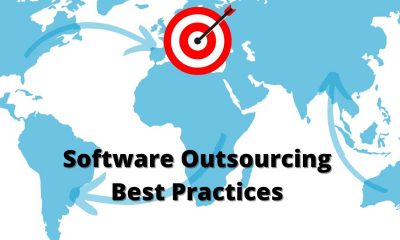

Developing a new product can be an exciting venture, but it’s important to understand the costs involved before diving in. The cost of developing a new...


I’m building an offshore tech team for AI software development to tap into global talent and cut costs. With AI transforming industries, having a dedicated team...
To succinctly summarize, creating a web application can be accomplished in a few days, particularly if you have a dedicated in-house team. However, outsourcing provides a...


Why Outsource Software Development to a Company? Outsourcing software development is an effective way to get the work done. It saves you time and money. You...
What is a compensation plan? A compensation plan refers to the structure and arrangement of financial rewards offered by an organization to its employees in exchange...
When it comes to offshore software development, the USA boasts some of the best companies in the industry. If you’re looking for top-notch service and expertise,...


Shortlist the best recruitment process outsourcing companies and streamline your hiring process effortlessly. When it comes to finding top talent, many businesses are turning to recruitment...
In an era where operational efficiency and premier customer service are paramount, many businesses are turning to the strategic advantage of outsource customer support. Such a...
Delivering exceptional customer service is a paramount goal for companies worldwide. However, achieving this goal requires more than just a skilled in-house team. Enter customer service...
When starting a tech business, many young entrepreneurs face a challenging question: Should I use a dev shop for initial product development? This post is meant...


When it comes to Nearshore Software Development, U.S. companies have a clear checklist of requirements that must be met by their potential partners. But what exactly are these...
Are you looking for a comprehensive resource on remote hiring? Look no further! In this complete guide, I will walk you through all the essential aspects...


Python is a general-purpose, high-level programming language that can be interpreted. Its design philosophy emphasizes code readability and the use of significant indentation. Python can be dynamically...


The software development industry is growing with lightning speed, yet the supply does not seem to match the high demand for products. And while the amount...

Each firm is exceptional in its functioning, aspects, overall performance, targets, and aims. With this specific identity arrives business-specific challenges which requires tailored software, applications, and...


Engineers who specialize in fintech software design, maintain, and update products with a financial element. Fintech developers are skilled in web&mobile development, as well as cutting-edge...

Have you ever thought about the potential benefits of outsourcing your company’s IT function? Plenty of owners do. The most common reasons they mention include two...


What is Outsourcing in Software Development? Outsourcing is a process of contracting out the development of software to an external software outsourcing company. Outsourcing has been...


Outsourcing is becoming a more common tool to cut costs as businesses learn to balance quality and cost. Outsourcing is not just about shipping manufacturing jobs...
Virtual assistants are the most sought-after subcategory of administrative support. As more companies realize the advantages of virtual assistants, they are increasingly in demand. You don’t have to...


Do you know what takes up a lot, if not most, of the time and resources of a startup company? Getting the business off the ground...


Details of Outsource Outsourcing doesn’t necessarily compromise quality. It is one of the most efficient ways to save cost. It requires constant monitoring, managing, and measuring...
Virtual assistants are the most sought-after subcategory of administrative support. As more companies realize the advantages of virtual assistants, they are increasingly in demand. You don’t have to...


Outsourcing your data entry can be a great way to save time and energy while still getting the job done accurately and efficiently. But before you...
Outsourcing typically costs more than in case the work was done in-house since you’re paying some `fixed expenses and profit’ dollars as a piece of the...


The Do’s and Don’ts of Outsource Outsourcing is critical because your company may just require your creative work from time to time. It has proved to...


Details of Outsource Outsourcing doesn’t necessarily compromise quality. It is one of the most efficient ways to save cost. It requires constant monitoring, managing, and measuring...
The 30-Second Trick for Outsource "Outsourcing" has come to be a terrible word in the United States of America. While it may prove highly beneficial for...


As the world has become more connective, businesses have also become more competitive. Companies have been forced to use various cost-cutting strategies to increase profits and...

What is software development in Argentina like? Outsource Company has been collaborating with software development teams in Argentina for a few years now. But I still...


Today, companies are striving to implement more and more technology solutions that help improve the productivity and customer focus of the business. One of them is...
As a customer, you will never have to deal with any of the typical frustrations of outsourcing your operations. With Argent Team, you can sleep soundly...


Remote team management is about keeping balance and being able to address the issues before they turn into major issues. Although work from home became a...
A Powerful Trident Software Outsourcing service should not be a one size fits all process. The outsourcing process for any project should be tailored to the...


Outsourcing can help cut costs and boost revenue, but it is not something to take on lightly. Outsourcing can completely reshape how your business operates, and...
Managing an offshore software development team is an important challenge you will face to have a successful business. However, to get to the main purpose of...


Nearshore outsourcing presents the most viable options considering cost, labor, and geography.


TOP Hospitality and Leisure Industry Technology Solutions #1 Xtreem Solution – We create simple yet powerful travel portals http://bit.ly/2M6zRyJ Xtreem Solution is a digital transformation consulting...


If you’re searching for the best offshore developers, you’re probably overwhelmed by companies pitching their services from all over the world. One easy way to narrow...
Curious if your business or upcoming project will make a good fit for outsourcing? The truth is that most software development projects are successful with the...